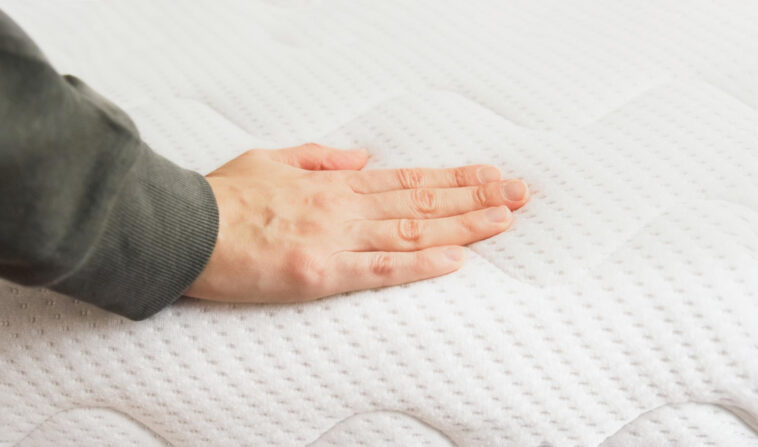In my hectic life today, I've come to realize just how vital a good night's sleep is. It's not just about feeling refreshed in the morning; it's about nurturing my overall health and well-being. One thing I've learned on this journey to better sleep is the incredible impact my mattress has on the quality of my rest. The only downside is, that buying a new mattress can be quite an investment.
That's when I stumbled upon the world of DIY mattress alternatives, and it's been a game-changer. These creative and cost-effective solutions have allowed me to enjoy comfort without emptying my wallet. So, if you're interested in discovering how to upgrade your sleep without breaking the bank, join me as we explore a variety of DIY mattress alternatives in this comprehensive guide.
Why Consider DIY Mattress Alternatives?
Before delving into the realm of DIY mattresses, it's essential to explore the compelling reasons for choosing this cost-effective option:
Cost Savings
The primary motivation behind considering DIY mattress alternatives is the potential for substantial cost savings. High-quality mattresses can come with a hefty price tag, making them inaccessible to many budget-conscious individuals. Opting for a DIY approach allows you to craft a comfortable sleeping surface without breaking the bank.
Customization
One of the standout advantages of DIY mattresses is the unparalleled level of customization they offer. When you embark on a DIY mattress project, you gain the freedom to tailor every aspect to your specific needs and preferences. From selecting the ideal materials and determining the desired firmness to customizing the size, you can create a personalized sleeping experience that caters to your unique requirements pillow inserts natural fillings.
Eco-Friendly Options
It's worth noting that numerous commercially available mattresses contain chemicals and materials that may have adverse effects on the environment. In contrast, DIY mattress alternatives often prioritize eco-friendliness and sustainability. By opting for natural and environmentally friendly materials, you can make a conscious choice to reduce your ecological footprint while enjoying a comfortable night's sleep. This eco-conscious approach aligns with the growing trend of environmentally responsible consumer choices and can contribute to a greener future.
Now that you understand the benefits, let's explore some popular DIY mattress alternatives in greater detail:

DIY Mattress Alternatives
DIY Foam Mattress
If you're in search of a budget-friendly yet comfortable mattress solution, a DIY foam mattress could be the answer. This project allows you to tailor your mattress to your specific preferences. Here's what you'll need and how to go about it:
Materials Needed
- High-density foam sheets: These are the core materials for your DIY foam mattress.
- Mattress cover: You'll need a cover to encase the foam layers and protect your mattress.
- Adhesive spray: This is used to attach the foam layers together securely.
Steps
- Measure and cut the high-density foam sheets: Start by measuring and cutting the high-density foam sheets to your desired mattress size. Whether you're creating a twin, queen, king, or any other size, precision in cutting is essential for a snug fit.
- Lay out the foam sheets in layers: To achieve your desired level of firmness and comfort, arrange the foam sheets in layers. You can experiment with different layer combinations until you find the ideal balance of support and softness.
- Use adhesive spray to attach the layers together: Once you're satisfied with the layer arrangement, use adhesive spray to bond the foam layers securely. This step ensures that the layers remain in place and do not shift over time.
- Place the assembled foam layers inside a mattress cover: Finally, slide the assembled foam layers into a mattress cover and zip it up securely. The cover serves as both protection fo
Tip: To enhance comfort, consider adding a memory foam topper on top of the DIY foam mattress.
The DIY Foam Mattress Explained
A DIY foam mattress is an excellent choice if you're looking for a comfortable yet budget-friendly option. High-density foam sheets are readily available and can be easily customized to your preferred mattress size. You can also layer the foam sheets to achieve your desired level of firmness, ensuring a good night's sleep.
High-density foam provides excellent support and contouring to your body, relieving pressure points and reducing tossing and turning during the night. By following the simple steps outlined above, you can create a DIY foam mattress that rivals many store-bought options inserts natural pillow fillings.
Futon Mattress
Futon mattresses are a versatile and cost-effective option that have been a favorite among budget-conscious individuals for years. They provide a simple yet space-saving bedding solution that can fit well into various room designs. If you're considering a futon mattress for your sleeping needs, here's what you need to know:
Materials Needed
- Futon frame or platform bed: You'll require a sturdy frame or platform bed designed to accommodate a futon mattress.
- Futon mattress: Choose a futon mattress in your preferred size and firmness level. These mattresses come in various sizes, from twin to queen, and offer different levels of firmness to suit your comfort preferences.
- Futon cover (optional): While optional, a futon cover can protect your futon mattress from wear and tear and also add a decorative element to your bedding setup.
Steps
- Purchase a futon mattress: Start by selecting a futon mattress that meets your size and firmness requirements. Futon mattresses come in various materials, such as cotton, foam, and innerspring, allowing you to choose one that aligns with your comfort preferences.
- Place the futon mattress on a futon frame or platform bed: Once you have your futon mattress, set it up on a futon frame or platform bed. Ensure that the frame or platform is sturdy and provides adequate support for the mattress. The simplicity of this setup allows for easy assembly and quick adaptation to different room layouts.
- Optionally, cover the futon mattress: To protect your futon mattress and add a decorative touch to your sleeping area, consider covering it with a futon cover. These covers come in a wide range of colors and designs, allowing you to match your bedding to your room's aesthetic.
Exploring the Futon Mattress Option
Futon mattresses have long been a popular choice for budget-conscious individuals seeking a simple and space-saving bedding solution. These mattresses are versatile and can be easily incorporated into various room designs.
When choosing a futon mattress, consider your preferred firmness level, as they come in various thicknesses and materials. While a futon mattress may not offer the same level of customization as some other DIY alternatives, they are a cost-effective option that provides comfort and convenience.
Read also our post on DIY Bed Rail for Elderly
DIY Innerspring Mattress
For those who prefer the classic feel of an innerspring mattress and are looking for a budget-friendly alternative, crafting your DIY innerspring mattress can be a rewarding project. Here's what you need and how to go about it:
Materials Needed
- Innerspring coils: Gather innerspring coils from an old mattress or purchase them separately. Ensure they are in good condition for optimal comfort and support.
- Fabric or mattress cover: You'll need a durable fabric or a specialized mattress cover to encase the mattress and provide a polished appearance.
- Upholstery materials: Upholstery materials like foam or cotton batting will be used to provide cushioning and enhance comfort.
Steps
- Gather innerspring coils: Begin by collecting innerspring coils from an old mattress or purchase them separately. Ensure that the coils are in good condition and free from damage. The number of coils you'll need depends on the desired mattress size and the level of support you prefer.
- Arrange the coils: Lay out the innerspring coils in a row, following the dimensions of your desired mattress size and shape. Properly spacing and aligning the coils is crucial for achieving a comfortable sleeping surface.
- Cover with upholstery materials: To enhance comfort, cover the innerspring coils with upholstery materials like foam or cotton batting. These materials provide cushioning and support, ensuring a restful night's sleep. Adjust the thickness of the upholstery materials based on your preference for mattress firmness.
- Wrap in fabric or use a mattress cover: To complete your DIY innerspring mattress, wrap the entire assembly in a durable fabric or use a specialized mattress cover. This step not only protects the mattress but also gives it a finished and polished appearance.
Exploring the DIY Innerspring Mattress
If you appreciate the traditional feel of an innerspring mattress and want to create your own without breaking the bank, a DIY innerspring mattress is an excellent option.
By reusing innerspring coils from an old mattress or purchasing them separately, you can save on costs while still enjoying the support and bounce associated with innerspring mattresses. Adding upholstery materials like foam or cotton batting enhances comfort, and wrapping the assembly in a fabric or using a mattress cover provides a polished look.
DIY innerspring mattresses are a practical choice for those who want to maintain the classic feel of traditional bedding without the high price tag sample mattress pod actual size.
Read also our post on DIY Day
Air Mattress with Toppers
If you're seeking a versatile and budget-friendly DIY mattress solution, consider using an air mattress combined with quality mattress toppers. This approach provides a comfortable and adjustable sleeping surface that can be easily customized to your preferences. Here's what you need and how to set it up:
Materials Needed
- Air mattress: Choose an air mattress that suits your size and firmness preferences.
- Mattress toppers: Select high-quality mattress toppers such as memory foam or latex, which offer varying degrees of softness and support.
- Bed sheets and bedding: Gather your favorite bed sheets and bedding for a cozy and inviting sleep environment.
Steps
- Inflate the air mattress: Begin by inflating the air mattress to your desired firmness level. This step allows you to tailor the mattress's firmness to your comfort needs. Some air mattresses come with adjustable settings for added convenience.
- Place the mattress toppers: Next, add one or more mattress toppers on top of the air mattress. The choice of mattress toppers is crucial here, as it determines the level of softness and support your DIY mattress will offer. Memory foam and latex toppers are popular choices for their comfort and adaptability.
- Complete with bedding: To complete your DIY mattress, cover it with your preferred bed sheets and bedding. This step not only enhances the aesthetics but also ensures a cozy and supportive sleeping surface.
The Air Mattress with Toppers: A Versatile DIY Solution
An air mattress combined with quality mattress toppers offers a versatile and comfortable DIY mattress solution. Air mattresses are affordable and easy to store when not in use, making them an excellent choice for occasional use or as a temporary bedding option.
The key to enhancing the comfort of an air mattress lies in the choice of mattress toppers. You can select from various materials such as memory foam or latex to create the desired level of softness and support. Adding your favorite bed sheets and bedding completes the setup, ensuring a cozy and restful night's sleep.
This DIY alternative is perfect for those who need flexibility and may have limited space for a permanent mattress setup.
DIY Natural Latex Mattress
If you're committed to sustainability and prefer natural materials for your bedding, creating a DIY natural latex mattress is a fantastic choice. Natural latex foam, derived from rubber tree sap, offers an eco-friendly and long-lasting option for your mattress project. Here's what you need to know to get started:
Materials Needed
- Natural latex foam layers: Purchase natural latex foam layers in various densities to achieve your desired firmness and support levels. Natural latex foam is a sustainable and biodegradable material, making it an environmentally responsible choice.
- Mattress cover: You'll need a mattress cover to encase the assembled latex layers and protect your DIY mattress.
- Adhesive or mattress tape: To secure the latex foam layers together, you can use an adhesive specifically designed for this purpose or mattress tape for a secure bond.
Steps
- Purchase natural latex foam layers: Begin by selecting natural latex foam layers that align with your preferences for firmness and support. Latex foam is available in different densities, allowing you to create a customized sleeping experience.
- Lay out the latex foam layers: Lay out the latex foam layers in the desired configuration, taking into account the mattress size you intend to create. Ensure that the layers are aligned properly for an even and supportive sleep surface.
- Secure the layers together: Use adhesive or mattress tape to secure the latex foam layers together. Ensure that the layers are firmly bonded to prevent shifting and maintain the integrity of your DIY mattress.
- Place the assembled latex layers in a mattress cover: To complete your DIY natural latex mattress, encase the assembled latex layers in a suitable mattress cover. This cover serves as protection for your mattress and provides a finished look.
The DIY Natural Latex Mattress: A Sustainable and Comfortable Choice
For those who prioritize sustainability and natural materials in their bedding choices, a DIY natural latex mattress is an excellent option. Natural latex foam is derived from rubber tree sap, making it an eco-friendly and durable choice for your DIY project.
By selecting latex foam layers in various densities, you can tailor the mattress to your preferred firmness and support levels. Latex mattresses are known for their excellent motion isolation and contouring properties, providing a comfortable and supportive sleep surface.
With a natural latex mattress, you not only save money but also contribute to a greener and more sustainable future.

Tips for Success with DIY Mattresses
Embarking on a DIY mattress project can be a fulfilling endeavor, but it's essential to be well-prepared for a successful outcome. Here are some crucial tips to enhance your DIY mattress-making experience:
In-Depth Research and Planning
The foundation of a successful DIY mattress project lies in thorough research and meticulous planning. Before you dive into your project, invest time in researching various materials and construction techniques. Create a comprehensive plan that outlines crucial details such as the mattress size, the materials required (e.g., foam, latex, springs), and any additional features you desire, such as pillow tops or mattress covers. Taking these steps will help you make informed decisions and set clear goals for your DIY mattress.
Prioritize Comfort Testing
Comfort is the ultimate objective when crafting your own mattress. To achieve the optimal level of comfort, don't hesitate to experiment with different materials and layer configurations. Consider incorporating mattress toppers or mattress pads into your design, as these can be easily adjusted to fine-tune the comfort level to your liking. Regularly test and adjust your mattress throughout the construction process to ensure it meets your specific comfort preferences.
Safety and Allergen Considerations
Prioritize the safety and well-being of yourself and your family. Ensure that all materials you use in your DIY mattress are safe and free from harmful chemicals. This consideration is especially vital if you or your household members have allergies or sensitivities. Research the materials' certifications and labels to verify their safety standards before incorporating them into your mattress.
Invest in Durability
While DIY mattresses are a cost-effective option, it's crucial not to compromise on durability. Invest in high-quality materials that can withstand regular use over an extended period. Cutting corners on materials may save you money initially, but it could lead to premature wear and tear, reducing the overall lifespan of your DIY mattress. Prioritize durability to ensure that your DIY mattress remains comfortable and supportive for an extended duration, making the investment worthwhile.
Conclusion
In my personal journey to improve my sleep quality, I've come to realize the immense importance of a good night's rest for overall well-being. While the cost of purchasing a new mattress often deterred me, I discovered DIY mattress alternatives that have truly transformed my sleep experience without straining my budget.
These DIY options offer cost savings, customization, and an eco-friendly approach that aligns with my commitment to sustainability. Whether crafting a foam mattress tailored to my preferences or repurposing innerspring coils for a comfortable bed, I've learned that achieving a comfortable and restful night's sleep is not only achievable but also empowering.
By selecting materials carefully, planning meticulously, and prioritizing comfort and safety, I've found that the path to better sleep can be both accessible and fulfilling. I encourage others to embark on this journey of DIY mattress solutions, as it has made a significant difference in my life, and it might do the same for them.
Sources
https://www.rootsimple.com/2013/03/a-homemade-mattress/
https://www.ncbi.nlm.nih.gov/pmc/articles/PMC3265077/
https://www.epa.gov/indoor-air-quality-iaq/inside-story-guide-indoor-air-quality




